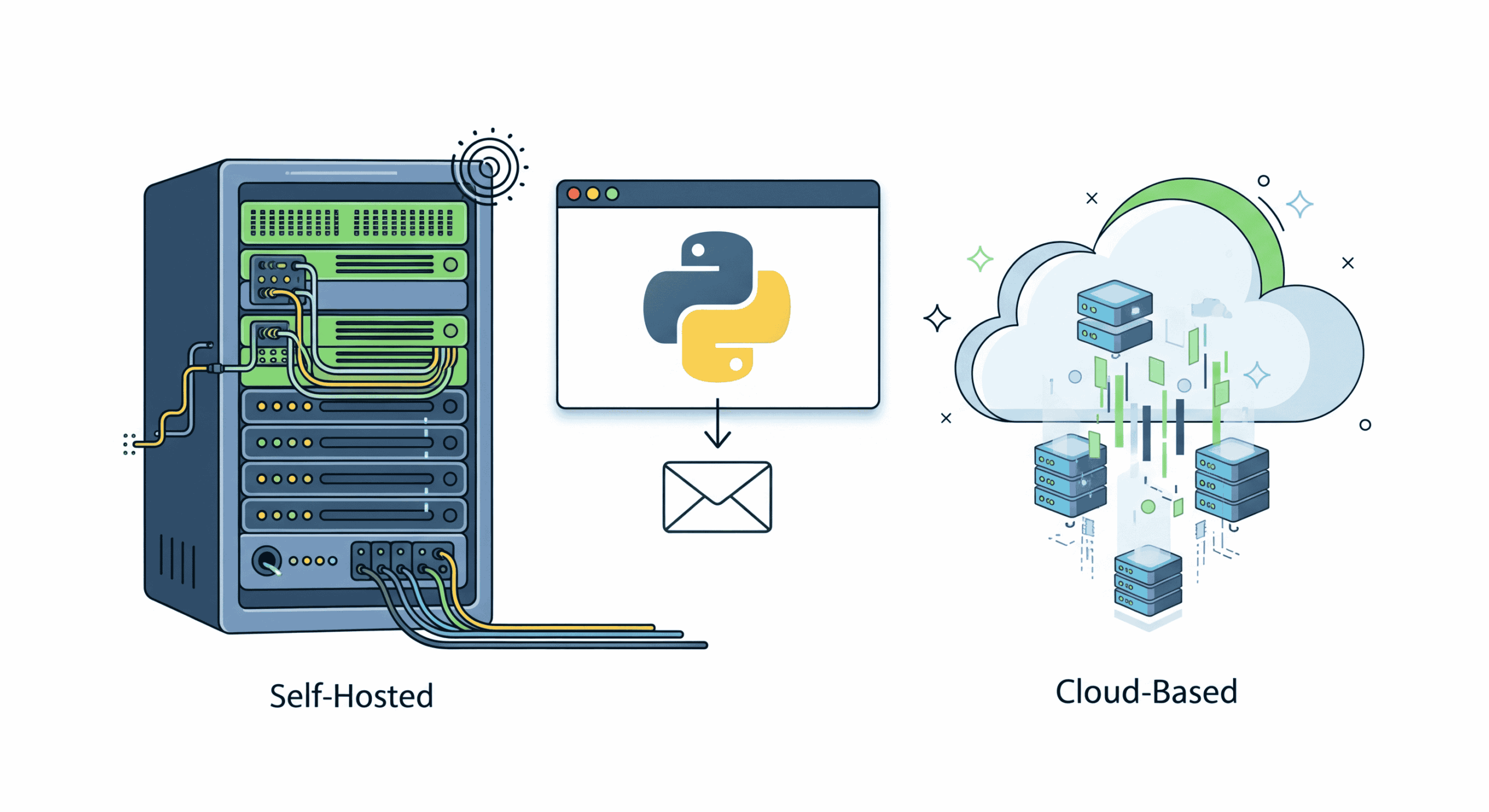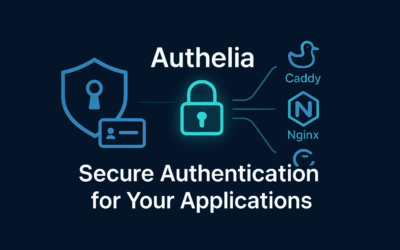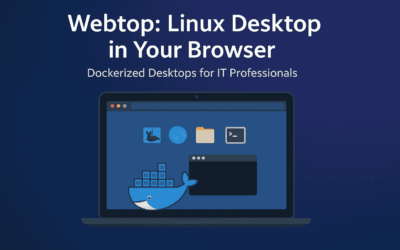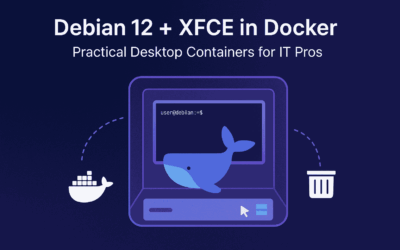Email Notifications for Your Scripts
Ever wondered if that long-running cron job actually finished? Or if your nightly backup script encountered an unexpected error? As IT professionals, we can’t afford to be in the dark. We need our automated systems to communicate their status reliably. That’s where email notifications come in, offering a simple and effective solution.
But before you start piping script output to the mail command, a critical question must be answered: how will you securely send these emails? This post will guide you through the process of setting up email notifications for your scripts using Python. More importantly, we’ll perform a risk-based analysis of the two primary methods—using a self-hosted SMTP server versus an online email service—to help you make the most secure choice for your environment.
Why Bother with Email Notifications?
For mission-critical systems, a “set it and forget it” approach is a non-starter. Email notifications provide an essential feedback loop, offering several key benefits:
- Monitoring Long-Running Tasks: Get an immediate report when a large data migration, a database synchronization, or a system backup is completed, saving you from manual checks.
- Proactive Error Alerting: Instead of discovering a failure hours or days later, an email alert can notify you the moment a script fails, allowing for a rapid response and minimizing downtime.
- Confirmation of Success: Even for routine tasks, a simple “Backup Successful!” email provides peace of mind and an auditable record of successful operations.
Our example for this post is a script that copies a file for backup purposes. We’ll use this scenario to demonstrate how to send a notification detailing the script’s success or failure.
A Simple Python Script
This script demonstrates the core functionality of copying a file and then sending an email based on the outcome. The code is written to be both functional and a teaching tool for best practices.
import shutil
import smtplib
from email.mime.text import MIMEText
import os # We'll need this for secure credential management
# --- File Copy Operation ---
source_file = '/path/to/source.log'
destination_folder = '/var/backups/'
try:
shutil.copy(source_file, destination_folder)
backup_status = "SUCCESS: Backup of source.log completed successfully."
except FileNotFoundError:
backup_status = "ERROR: Source file not found. Backup failed."
except Exception as e:
backup_status = f"CRITICAL: An unexpected error occurred during backup - {e}"
# --- Email Notification Setup ---
# Always retrieve credentials securely from environment variables or a secrets manager.
smtp_server = "your_smtp_server.com"
smtp_port = 587
sender_email = "alerts@yourdomain.com"
password = os.environ.get('SMTP_PASSWORD')
receiver_email = "admin@yourdomain.com"
# --- Create and Send the Email ---
msg = MIMEText(backup_status)
msg['Subject'] = 'System Backup Status Report'
msg['From'] = sender_email
msg['To'] = receiver_email
if password is None:
print("ERROR: SMTP password not found in environment variable. Email not sent.")
else:
try:
with smtplib.SMTP(smtp_server, smtp_port) as server:
server.starttls()
server.login(sender_email, password)
server.sendmail(sender_email, receiver_email, msg.as_string())
print("Email notification sent successfully.")
except Exception as e:
print(f"Failed to send email: {e}")
Security Warning: I cannot emphasize this enough. NEVER hard-code sensitive credentials like passwords directly into your script. The example above has been updated to use an environment variable (os.environ.get('SMTP_PASSWORD')), which is a more secure practice. For enterprise-level use, consider a dedicated secrets management tool.
Self-Hosted vs. Online Services
The choice of SMTP backend is not a trivial one. It’s a strategic decision that affects your security posture, reliability, and maintenance load.
The Self-Hosted Approach
This means you are responsible for running your own mail server software (MTA) on your infrastructure.
Pros:
- Complete Control: You have full ownership of your data, the mail queues, and the entire sending process. This is critical for environments with stringent data sovereignty and compliance requirements (e.g., GDPR, HIPAA).
- No Third-Party Reliance: You don’t introduce a new third-party dependency into your alert chain, reducing supply chain risk.
Cons:
- High Complexity and Vulnerability Risk: Setting up an MTA is a non-trivial task. A single misconfiguration can lead to your server becoming an open relay, a target for spammers, and ultimately, an IP blacklisted by major providers.
- Deliverability Issues: Without proper DNS records (SPF, DKIM, DMARC), your notifications are highly likely to be flagged as spam, defeating the purpose of the alert.
- Significant Maintenance Overhead: You are responsible for all patching, log analysis, and troubleshooting. This is a considerable ongoing time investment for your team.
Analogy: Think of this as building your own security system from scratch. You control everything, but you must be a master of every component—from the locks on the doors to the firewall. It’s a massive undertaking with a high-stakes failure state.
The Online Service Approach
This is the more common and recommended approach, where you utilize a third-party service (e.g., SendGrid, Mailgun, or your enterprise’s Microsoft 365/Google Workspace account) to handle email delivery.
Pros:
- High Reliability & Deliverability: These services are specialists. They maintain excellent sender reputations and robust infrastructure to ensure your emails reach the inbox, not the junk folder.
- Reduced Attack Surface: The provider is responsible for securing the mail servers. Your attack surface is limited to the single API key or App Password you use.
- Ease of Management: Configuration is simple, typically requiring just a few credentials. Maintenance and scalability are handled for you, freeing up your team’s resources.
Cons:
- Third-Party Risk: You are dependent on an external service. An outage on their end will affect your notifications. You also need to trust them with your email metadata.
- Credential Management: While easier, managing credentials is still a top priority. A compromised API key or App Password can be exploited.
- Cost & Policy Constraints: While free tiers exist, high volumes will incur costs. You are also subject to the service’s policies, and a violation could lead to account suspension.
Analogy: This is like using a managed security service. You’re leveraging a team of experts with specialized tools and infrastructure. It’s more reliable, easier to set up, and you’re protected by their expertise, but you have to trust them and their systems.
Summary Table
| Feature | Self-Hosted SMTP Server | Online Email Service |
| Setup & Maintenance | High complexity; requires deep technical knowledge. | Low complexity; easy to configure. |
| Deliverability | Difficult to ensure; high risk of emails being marked as spam. | High; services have established reputations. |
| Security Risk | High; requires meticulous hardening and patching. | Reduced; shifts burden to provider, but requires secure credential management. |
| Cost | Upfront hardware/server cost; low per-email cost. | Often free for low volume; per-email cost for high volume. |
| Data Sovereignty | Complete control over all data. | Metadata is processed by a third party. |
Final Thoughts
For the vast majority of IT professionals, and especially for script-based notifications, the online email service approach is the clear and secure choice. The reduced operational overhead, superior deliverability, and managed security benefits are invaluable. While self-hosting offers ultimate control, the associated security risks and significant maintenance burden make it a viable option only for organizations with very specific, non-negotiable requirements and the dedicated expertise to manage it.
The key takeaway is to prioritize security. Regardless of which method you choose, always manage your credentials using robust, secure methods like environment variables or a secrets manager.




